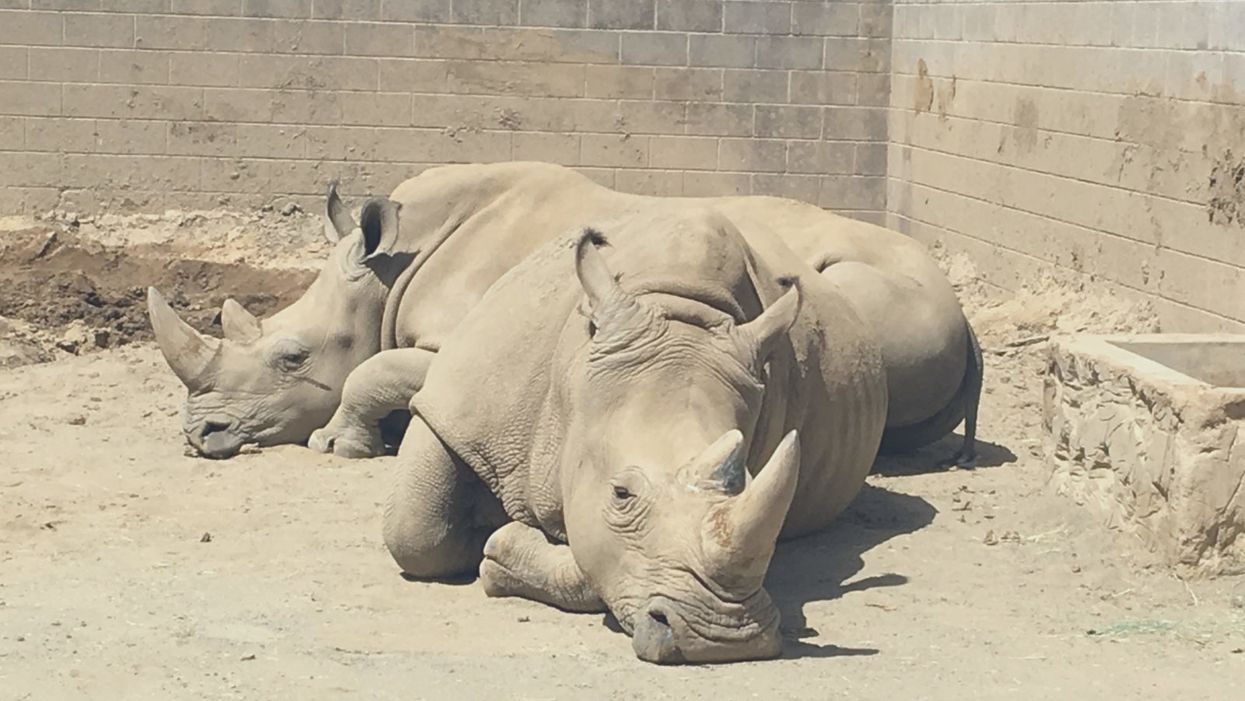Dadbot, Wifebot, Friendbot: The Future of Memorializing Avatars
In 2015, about a year before he was diagnosed with terminal lung cancer, John Vlahos posed for a picture with his son, James.
In 2016, when my family found out that my father was dying from cancer, I did something that at the time felt completely obvious: I started building a chatbot replica of him.
I simply wanted to create an interactive way to share key parts of his life story.
I was not under any delusion that the Dadbot, as I soon began calling it, would be a true avatar of him. From my research about the voice computing revolution—Siri, Alexa, the Google Assistant—I knew that fully humanlike AIs, like you see in the movies, were a vast ways from technological reality. Replicating my dad in any real sense was never the goal, anyway; that notion gave me the creeps.
Instead, I simply wanted to create an interactive way to share key parts of his life story: facts about his ancestors in Greece. Memories from growing up. Stories about his hobbies, family life, and career. And I wanted the Dadbot, which sent text messages and audio clips over Facebook Messenger, to remind me of his personality—warm, erudite, and funny. So I programmed it to use his distinctive phrasings; to tell a few of his signature jokes and sing his favorite songs.
While creating the Dadbot, a laborious undertaking that sprawled into 2017, I fixated on two things. The first was getting the programming right, which I did using a conversational agent authoring platform called PullString. The second, far more wrenching concern was my father's health. Failing to improve after chemotherapy and immunotherapy, and steadily losing energy, weight, and the animating sparkle of life, he died on February 9.

John Vlahos at a family reunion in the summer of 2016, a few months after his cancer diagnosis.
(Courtesy James Vlahos)
After a magazine article that I wrote about the Dadbot came out in the summer of 2017, messages poured in from readers. While most people simply expressed sympathy, some conveyed a more urgent message: They wanted their own memorializing chatbots. One man implored me to make a bot for him; he had been diagnosed with cancer and wanted his six-month-old daughter to have a way to remember him. A technology entrepreneur needed advice on replicating what I did for her father, who had stage IV cancer. And a teacher in India asked me to engineer a conversational replica of her son, who had recently been struck and killed by a bus.
Journalists from around the world also got in touch for interviews, and they inevitably came around to the same question. Will virtual immortality, they asked, ever become a business?
The prospect of this happening had never crossed my mind. I was consumed by my father's struggle and my own grief. But the notion has since become head-slappingly obvious. I am not the only person to confront the loss of a loved one; the experience is universal. And I am not alone in craving a way to keep memories alive. Of course people like the ones who wrote me will get Dadbots, Mombots, and Childbots of their own. If a moonlighting writer like me can create a minimum viable product, then a company employing actual computer scientists could do much more.
But this prospect raises unanswered and unsettling questions. For businesses, profit, and not some deeply personal mission, will be the motivation. This shift will raise issues that I didn't have to confront. To make money, a virtual immortality company could follow the lucrative but controversial business model that has worked so well for Google and Facebook. To wit, a company could provide the memorializing chatbot for free and then find ways to monetize the attention and data of whoever communicated with it. Given the copious amount of personal information flowing back and forth in conversations with replica bots, this would be a data gold mine for the company—and a massive privacy risk for users.
Virtual immortality as commercial product will doubtless become more sophisticated.
Alternately, a company could charge for memorializing avatars, perhaps with an annual subscription fee. This would put the business in a powerful position. Imagine the fee getting hiked each year. A customer like me would find himself facing a terrible decision—grit my teeth and keep paying, or be forced to pull the plug on the best, closest reminder of a loved one that I have. The same person would effectively wind up dying twice.
Another way that a beloved digital avatar could die is if the company that creates it ceases to exist. This is no mere academic concern for me: Earlier this year, PullString was swallowed up by Apple. I'm still able to access the Dadbot on my own computer, fortunately, but the acquisition means that other friends and family members can no longer chat with him remotely.
Startups like PullString, of course, are characterized by impermanence; they tend to get snapped up by bigger companies or run out of venture capital and fold. But even if big players like, say, Facebook or Google get into the virtual immortality game, we can't count on them existing even a few decades from now, which means that the avatars enabled by their technology would die, too.
The permanence problem is the biggest hurdle faced by the fledgling enterprise of virtual immortality. So some entrepreneurs are attempting to enable avatars whose existence isn't reliant upon any one company or set of computer servers. "By leveraging the power of blockchain and decentralized software to replicate information, we help users create avatars that live on forever," says Alex Roy, the founder and CEO of the startup Everlife.ai. But until this type of solution exists, give props to conventional technology for preserving memories: printed photos and words on paper can last for centuries.
The fidelity of avatars—just how lifelike they are—also raises serious concerns. Before I started creating the Dadbot, I worried that the tech might be just good enough to remind my family of the man it emulated, but so far off from my real father that it gave us all the creeps. But because the Dadbot was a simple chatbot and not some all-knowing AI, and because the interface was a messaging app, there was no danger of him encroaching on the reality of my actual dad.
But virtual immortality as commercial product will doubtless become more sophisticated. Avatars will have brains built by teams of computer scientists employing the latest techniques in conversational AI. The replicas will not just text but also speak, using synthetic voices that emulate the ones of the people being memorialized. They may even come to life as animated clones on computer screens or in 3D with the help of virtual reality headsets.
What fascinates me is how technology can help to preserve the past—genuine facts and memories from peoples' lives.
These are all lines that I don't personally want to cross; replicating my dad was never the goal. I also never aspired to have some synthetic version of him that continued to exist in the present, capable of acquiring knowledge about the world or my life and of reacting to it in real time.
Instead, what fascinates me is how technology can help to preserve the past—genuine facts and memories from people's lives—and their actual voices so that their stories can be shared interactively after they have gone. I'm working on ideas for doing this via voice computing platforms like Alexa and Assistant, and while I don't have all of the answers yet, I'm excited to figure out what might be possible.
[Adapted from Talk to Me: How Voice Computing Will Transform the Way We Live, Work, and Think (Houghton Mifflin Harcourt, March 26, 2019).]
The Best Kept Secret on the International Space Station
Rendering of Space Tango ST-42 autonomous commercial manufacturing platform in Low Earth Orbit. (Courtesy Space Tango)
[Editor's Note: This video is the second of a five-part series titled "The Future Is Now: The Revolutionary Power of Stem Cell Research." Produced in partnership with the Regenerative Medicine Foundation, and filmed at the annual 2019 World Stem Cell Summit, this series illustrates how stem cell research will profoundly impact life on earth.]
Kira Peikoff was the editor-in-chief of Leaps.org from 2017 to 2021. As a journalist, her work has appeared in The New York Times, Newsweek, Nautilus, Popular Mechanics, The New York Academy of Sciences, and other outlets. She is also the author of four suspense novels that explore controversial issues arising from scientific innovation: Living Proof, No Time to Die, Die Again Tomorrow, and Mother Knows Best. Peikoff holds a B.A. in Journalism from New York University and an M.S. in Bioethics from Columbia University. She lives in New Jersey with her husband and two young sons. Follow her on Twitter @KiraPeikoff.
“Jurassic Park Without the Scary Parts” Is Actually Happening
Two of six female Southern white rhinos who were brought to the San Diego Safari Park to serve as surrogate mothers for the embryos that scientists hope to make from gametes from induced pluripotent stem cells.
[Editor's Note: This video is the first of a five-part series titled "The Future Is Now: The Revolutionary Power of Stem Cell Research." Produced in partnership with the Regenerative Medicine Foundation, and filmed at the annual 2019 World Stem Cell Summit, this series illustrates how stem cell research will profoundly impact life on earth. A new video will be published every Monday this month.]
Kira Peikoff was the editor-in-chief of Leaps.org from 2017 to 2021. As a journalist, her work has appeared in The New York Times, Newsweek, Nautilus, Popular Mechanics, The New York Academy of Sciences, and other outlets. She is also the author of four suspense novels that explore controversial issues arising from scientific innovation: Living Proof, No Time to Die, Die Again Tomorrow, and Mother Knows Best. Peikoff holds a B.A. in Journalism from New York University and an M.S. in Bioethics from Columbia University. She lives in New Jersey with her husband and two young sons. Follow her on Twitter @KiraPeikoff.


